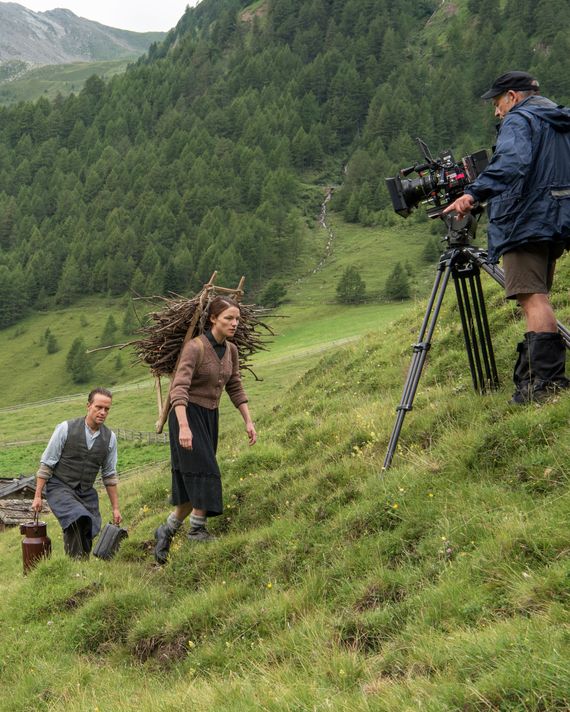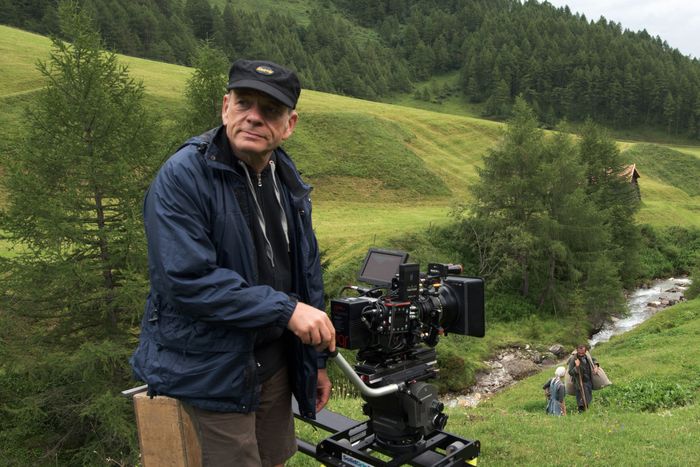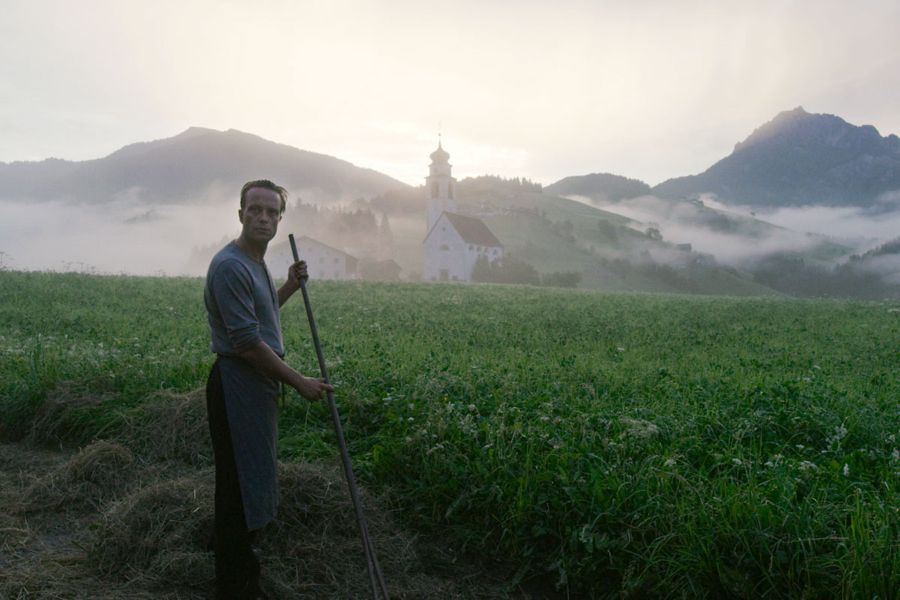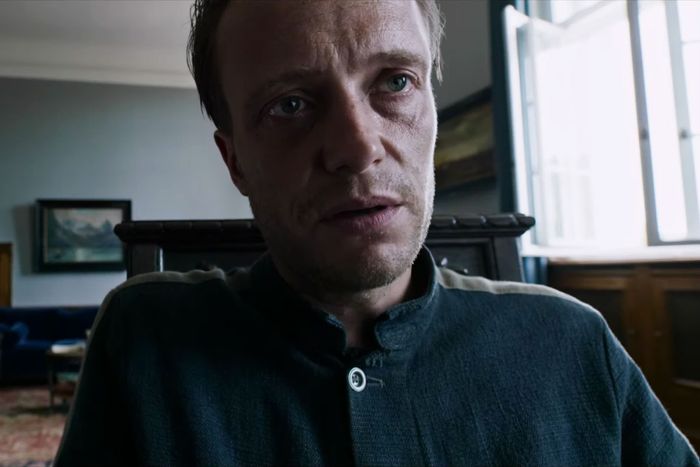
Terrence Malick calls them “rabbit holes.” The term refers to scenes (or images, or quick exchanges) that can be shot when the light’s not right. “He’s not a fan of blue skies,” says Scott Kirby, first assistant director on the filmmaker’s latest, the historical drama A Hidden Life. “If the sky is too blue, and he can’t quite get the image he’s looking for, he’ll say, ‘Let’s jump over there, and we’ll do a small scene in the shade of the wall of that house.’”
Then there’s “quail hunting.” Here’s how production designer Sebastian Krawinkel describes that term: “Sometimes, on set, or even on the way to set, if Terry sees the perfect light by accident, or if he sees a perfect moment, like the actor is lying in the shadow under a tree and there’s a fly on his nose, for example — that’s what he calls quail hunting. It’s a shy moment that he likes to capture.” A Hidden Life star August Diehl, who plays Franz Jägerstätter, an Austrian farmer imprisoned and executed during World War II for refusing to pledge loyalty to Hitler, recalls one such instance on the movie’s bucolic South Tyrol location: “I was sleeping on the meadow, because I was so exhausted, and when I woke up the camera was here,” he says, holding his hand a few inches from his face. “They’re filming everything!”
Malick’s got other favorite terms as well, borrowed not just from nature but also from art. “He sometimes cubizes scenes, which means that he will take a scene and shoot it in three or four different places,” says Kirby. Malick might cut among these different locations during the scene itself, leading to a pointed abstraction — a sense that what we are watching is not necessarily a specific narrative incident, but an idea manifesting itself in the world.
And then there’s my personal favorite: “Vermeer yourself,” which is how Malick encourages his actors to place themselves in the right light during a scene. “We only worked with natural light, so when we were shooting inside, we ourselves were in charge of knowing where the sunlight was coming in — and how our faces work in it,” recalls Valerie Pachner, who plays Franz’s wife, Franziska, or Fani. “It’s not easy,” she says, laughing. “Normally, you can just act. But now you also have to think, Play the light, or Vermeer yourself.”
A Terrence Malick set sounds like it’d be both exhausting and exhilarating. The camera is always rolling, it seems, sometimes for 30 minutes at a time (A Hidden Life is his first picture shot entirely digitally, which means that nobody ever had to pause to change a film reel), and the actors are constantly in motion. “Keep moving” is one of his most common directions. “He wanted us to move all the time,” Pachner recalls. “It’s kind of weird, because I come from the stage, where a movement always means something. Also, my character is a farmer, and a very grounded person. She’s not dreamy. So, the challenge was to keep moving while still making it feel authentic.”
The movement in A Hidden Life is never dreamy. Sometimes, it’s joyful. Sometimes, it’s tense. Often, it’s enraged. This sense of constant motion has been a common motif in Malick’s recent work, and I’ve argued, in my review of A Hidden Life, and elsewhere, that this could be seen as dance — that his drama is often expressed through movement and the positioning of the actors, not just through their words or narrative events. “At the beginning, I was thinking, Why should I move the whole time, when I don’t even know where to go and why?,” Diehl says. “But then, after a while, you realize that it’s a dance. There’s a musical flow to everything.”
Cinematographer Jörg Widmer, who has served as a cameraman and second-unit cinematographer on Malick’s previous films, found his camera moving across the landscapes of A Hidden Life (which was shot in Italy, Germany, and Austria). “If you watch it carefully, you’ll see that there’s almost no still frame in the whole movie,” he says. “Emotionally, it was very important that the camera moves.” His movement was enhanced by extreme wide-angle camera lenses, which heighten and extend even the smallest of gestures. Such lenses distort the image while also making sure we see as much of this world as possible; the foreground seems unnaturally close, while the background feels impossibly distant. A person turning away from you on a rural path now looks like they’re walking away into the mists of time. Within a single shot, Widmer and Malick can achieve both great intimacy as well as a kind of totalizing, Olympian grandeur.
That Terrence Malick doesn’t make movies like other people make movies, of course, is not news. He has followed his own particular muse — thematically, stylistically, professionally — ever since returning from a 20-year filmmaking hiatus with 1998’s magnificently diffuse, otherworldly war epic The Thin Red Line. Each subsequent Malick effort has been less beholden to narrative, alternating between metaphysical ruminations and offhand moments assembled together like symphonic collages rather than stories. Adding to the nature metaphors, he has likened his process to catching fish, or “walking down the garden path” — he’s more interested in discovering things rather than just staging scenes. He is allergic to anything that feels presentational, or premeditated, or overly composed. He cuts out, or greatly abbreviates, scenes that merely move a plot forward. He casts actors, sometimes even big ones, in major roles, only to then excise their characters entirely in postproduction. (Sometimes, they become cameos: Matthias Schoenaerts shows up for a hot second in A Hidden Life.) He shoots multiple films back-to-back, then cuts them simultaneously with teams of editors who are constantly experimenting with new ways of conveying ideas and feelings.
It’s filmmaking at the speed of thought: To those of us enraptured by Malick’s work, these pictures feel like a direct channel into their subjects’ troubled consciousness. The images and words onscreen, for all their beauty, have a bracing intimacy and rawness, as if we’re seeing and hearing thoughts and emotions before they become something more proper, polished, or postured. Of course, to Malick’s detractors — and there are many — it all sounds like pretentious hooey.
A Hidden Life, however, represented a new chapter for Malick. Ever since 2011’s Oscar-nominated The Tree of Life, the publicity-shy director had been working in a somewhat autobiographical, improvised vein. That film was loosely based on his childhood growing up in Texas, with a stern father and a kindly mother, and two younger brothers, one of whom later committed suicide. To the Wonder (2013), Knight of Cups (2016), and Song to Song (2017), his first pictures set entirely in the present day, seemed to address events from his adult life: divorce, creative crisis, spiritual longing. (“He’s exposing what seems to be so much of his life — or at least what I thought was so much of his life — that it shocked me that he would do that,” Malick’s longtime friend and production designer Jack Fisk told me in 2018.) Those projects reportedly did have scripts, but very few people ever actually saw them, as Malick wanted to move as far away from traditional production as possible.
As a result, these later films have a rambling, underdeveloped quality that has alienated many viewers, including some of the director’s admirers. Malick himself suggested in 2017 that he had gone as far as he could with these improvised, free-form movies. “There’s a lot of strain when working without a script, because you can lose track of where you are,” he told a National Air and Space Museum audience in 2017 during a rare public appearance. “It’s very hard to coordinate with others who are working on the film … The reason we did it was to try and get moments that are spontaneous and free. As a movie director, you always feel with a script that you’re trying to fit a square peg into a round hole. And with no script, there’s no round hole; there’s just air. But I’m backing away from that style now.”
For A Hidden Life, then, the director reconciled his particular style of filmmaking with a more narrative approach. Maybe that’s one reason why it’s gotten some of the best reviews of any Malick film since The Tree of Life. The picture is a historical drama about real people, and it tells a story we might describe as important and urgent, about a conscientious objector who refused to have anything to do with the Nazis, and went to his grave defiant in the face of those who told him he could save himself if he just signed a piece of paper. The devout Franz Jägerstätter was beatified as a martyr by the Catholic Church in 2007 and is now considered a hero. But his family, including Fani (who died in 2013, at the age of 100) and his three daughters, were treated as outcasts and traitors by many of their fellow Austrians well into the 1990s. “The whole family was ostracized, and Franz was seen as this crazy person,” says Pachner. “The daughters told me that when they got married, their mom would say, ‘It’s good. Now your last name is not Jägerstätter.’”
Much of A Hidden Life is based on letters Fani and Franz sent during his incarceration. So the film is historical, but it’s not impersonal. Nobody seems to know when the director first started thinking about tackling this story, but it certainly relates to themes he’s been mulling for decades. As a philosophy student at Harvard, Malick pored over the work of Martin Heidegger, the enormously influential philosopher whose membership in the Nazi Party in the 1930s and ’40s profoundly complicated his legacy. Sometime in the mid-1960s, Malick even tracked down Heidegger, who was living a somewhat reclusive existence in Germany’s Black Forest at the time. Interestingly enough, their connection evidently came through another legendary philosopher and writer, one who had fled the Third Reich: Hannah Arendt, who famously coined the term “the banality of evil” in her 1961 reporting on the trial of Nazi war criminal Adolf Eichmann.
“[Malick] met Hannah Arendt while he was studying in Germany,” says Karl Markovics, a veteran Austrian actor who plays the mayor of Franz’s village in A Hidden Life, a character who finds his most hateful impulses unleashed in the wake of the Nazi takeover. “He mentioned to me that he met Arendt more or less accidentally, and she was on her way to meet Heidegger, so she invited him.” He doesn’t know what Malick and Heidegger talked about, but anyone who’s studied the philosopher’s work has had to reckon, at some point, with his disturbing history.
Today, it’s not hard to fathom why that long-ago meeting might have been on Malick’s mind, or why the banality of evil — the idea that great horrors can be perpetrated by seemingly ordinary people sitting behind desks doing seemingly ordinary jobs — might have presented itself in recent years as a good subject for a film. Much of A Hidden Life is structured as a series of exchanges between Franz and individuals who populate the mundane machinery of a fascist state — bureaucrats, bishops, local officials, military officials — as we hear their self-justifications. Some are delusional. Some are moral cowards, compelled to become hell’s middle managers so that they themselves won’t share Franz’s fate. Though we’re given no details about them as people, their attitudes are familiar: They’re scared, or weak, or haunted, or just practical. Franz’s lawyer, a mild-mannered man who seems to have little fondness for the Nazis, tells him he could save his life (and spare his family great agony) if he would just pledge his loyalty on paper. He even lulls us into thinking it would all be okay: We forget, for a second, to whom he’s asking Franz to declare loyalty. It’s the uncanny familiarity of this world that is so frightening.
I’m tempted to say that the film contrasts this corrosive portrait of bureaucrats and courts and collaborators with the open-air wonder of life on the farm. Nature often has a redemptive power in Malick’s work, and there’s an earthy immediacy to the scenes set in and around the Jägerstätters’ town of Radegund — the result, probably, of the actors actually toiling in the fields and doing real farm work, with Malick shooting their efforts much as one might a documentary. But the once-Edenic simplicity of their life appears to have been … not a mirage, exactly, but something far more fleeting: a flash of happiness and a glimpse, perhaps, of a better world that never quite came to be.
Because there’s hate swirling around the meadows of Radegund as well. When Franz’s position becomes known, he’s attacked by his fellow villagers. Later, Fani is scorned and abused by those around her. Markovics’s mayor character howls with rage about immigrants and other races he deems inferior, in lengthy outbursts based on the actor’s own improvisations. “The movie starts with images from Triumph of the Will,” says Markovics. “There we see masses of people, and they are like the atoms of an element. The element is the ideology, which is made up of all these single individuals in the crowd. For Terrence Malick, the mayor was like one of these atoms — he was separated from the crowd, but he was acting like a free radical of this big element of Nazi ideology.” The mayor’s tirades are buffoonish, but also terrifying — not unlike a certain German chancellor, or, frankly, a certain American president.
Even though A Hidden Life was shot just before Donald Trump’s election, the rise in tribalism across the globe and the emergence of newly emboldened nationalist parties clearly gives the movie a present-day urgency, as well as a political kick absent from much of Malick’s previous work. “Europe is being overrun by right-wing parties. They’re all coming back, and we’ve lost our sense of history,” says Diehl, who recalls long conversations with the director about politicians’ using fear of immigrants to gain power, particularly after the July 2016 truck attack in Nice, France, which occurred during the film’s production.
Of course, one should be careful of assuming too much about Malick’s politics; he doesn’t give interviews about anything, let alone his electoral opinions. And for all its religious imagery, and despite its morally upright protagonist, A Hidden Life is not interested in proselytizing. The director’s unique style of working — his obsession with finding and privileging casual, quiet moments, all that quail hunting and going down rabbit holes — establishes a baseline of humanism to this world, which in turn allows us to better understand how people can be twisted and perverted. Evil in the film is not a specific thing, or a person, but rather a kind of poison that corrupts each individual in his or her own way. And the poison never really goes away.
Read about composer James Howard Newton’s work on A Hidden Life’s score here.





